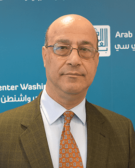
The death of former Iranian President Ali Akbar Hashemi Rafsanjani comes at a critical time in the Islamic Republic’s political history. As one of the founders of the new Iranian religious state and a member of its vanguard since 1979, Rafsanjani’s departure deprives one of its two foremost political blocs, the reformist conservatives, of a voice within a system so far controlled by Supreme Leader Ali Khamenei and his principal cohorts dedicated to the ideology of wilayat al-faqih, or custodianship of the Islamic jurist.
As speaker of the Iranian Shura Council (1980-89) and president (1989-97), Rafsanjani helped lay the institutional foundations of the revolutionary state. But as a member and leader (at different times) of its Guardian Council, Assembly of Experts, and Expediency Council, he worked both to find common ground between the different power centers of the republic and to defend the principles upon which it rested. Whatever his ideological proclivities, he—like all other officials, reformist and ultra-conservative—believed in the survival of the religious state as the best system for a virtuous Islamic presence and future. Where he broke with the ultra-conservatives from Khamenei’s circle was in the extent to which the state must adhere to the ideological underpinnings of founding Ayatollah Ruhollah Khomeini’s obscure wilayat al-faqih and its relationship with the outside world.
Many of Rafsanjani’s ilk inside Iran, and among religious scholars in Iraq, Bahrain, and Lebanon, long ago doubted and continue to question the late Ayatollah’s doctrine. Indeed, Khomeini found it necessary to sideline many early revolutionaries among the clerical class when they opposed his esoteric interpretation of Shiite jurisprudence. Upon his death and Khamenei’s ascension—Rafsanjani facilitated the latter’s choice as Supreme Leader despite his junior religious status and paucity of writings and knowledge—the position of al-wali al–faqih (the jurist guardian) became a utilitarian vehicle for ultra-conservative control of the myriad power centers of the state and for legitimizing their policies and practices. Rafsanjani represented a bloc of religious reformists and politicians who saw that the future of the state lay in a less socially conservative ideology and in a diminished role for the all-powerful Supreme Leader.
Moreover, since his presidency, which coincidentally started when Khomeini died in 1989, Rafsanjani sought to steer Iranian foreign policy toward openness to the Arab neighborhood and the West. Ever the consummate capitalist, Rafsanjani understood that Iran’s economy after the devastating Iran-Iraq war of 1980-88 needed investments and knowhow. The international environment after the collapse of the Soviet Union, the end of the Cold War, and the launching of former President George H.W. Bush’s New World Order after the 1991 Gulf War was naturally an American-dominated landscape and Rafsanjani had no qualms about re-establishing relations with the United States and the West.
However, the principalists’ backlash against his overtures and against the relaxing social atmosphere during the presidency of his successor, Mohammad Khatami (1997-2005), halted the opening. Iran’s quest to develop a peaceful nuclear program, initially begun during the late shah’s reign in the 1970s, George W. Bush’s ascension to the American presidency in 2001, and the 2005 election of ultra-conservative President Mahmoud Ahmadinejad all but doomed any talk of an Iranian strategy regarding the West.
Rafsanjani’s instrumental role in the election of current reformist President Hassan Rouhani and in smoothing inter-institutional relations since 2013 was credited with paving the way for the signing of the 2015 Joint Comprehensive Plan of Action (JCPOA) between Iran and the “P+5” group of countries. Importantly, this nuclear accord helped lift long-established international sanctions on the Islamic Republic of Iran and started its economic re-integration into the international economy after decades of isolation.
As an institutional source of support and legitimacy for Rouhani and his government, Rafsanjani will be terribly missed. There are no others of his stature, history, and connections into the system who can smooth the myriad obstacles in the face of Rouhani’s executive leadership. At this juncture of great trepidation from an ascendant revisionist Trump presidency, the rise of sectarian polarization in the Middle East, a commitment to a hegemonic agenda from Tehran to Damascus and Beirut, and an unsure outcome of a still shaky JCPOA, Rafsanjani’s absence is bound to cause great uncertainty.
But at the moment, his death will be felt most deeply in the camp of reformists coalescing around President Rouhani, whose re-election in the upcoming elections in May 2017 cannot be assured. Both as a representative of an agenda for domestic reform of institutions, policies, and practices and a standard bearer of openness to the outside world, Rouhani will be the main target of ultra-conservative attacks from powerful elements in the Guardian Council, the Shura Council, and the Islamic Revolutionary Guards Corps. Ultimately, however, and while his political future may democratically rest with the Islamic Republic’s voters, a decisive factor will be Supreme Leader Khamenei’s opinion on whether Iran should choose to continue with Rafsanjani’s gradual return to normalcy or veer toward re-erecting barriers to its relations with the international community.

